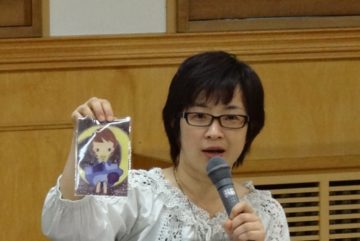Nobuki: There were many who took refuge in emergency shelters. Large emergency shelters were set-up. It was reported that the Emperor had visited such shelters.
Ms. K: Yes, His Imperial Majesty came to console the evacuees. I heard from my friend that Governor Ishihara of Tokyo accompanied him to the evacuation center and said “Nobody here is in great need, Your Majesty”. Hearing his remarks, my friend had no choice but to nod in agreement. Certainly, people whose cars were washed away by the tsunami could not reach there. People in great need were those who did not have money to buy cars and gas. There were those who were hit by the tsunami and were badly injured. It was reported that they would be given 1 or 2 liters of water a day. But in actual fact, it was only half a glass of water in the morning, and some bread. Yet, they were made to feel guilty of having just that.
Nobuki: We were very much indignant at Governor Ishihara’s remarks that the earthquake was divine retribution. The media had reported mainly on the earthquake and its disasters in Iwate and Miyagi Prefectures but very little on Fukushima. It was only in June that I came to know of the agony of the evacuees: they continued to be concerned about their relatives, neighbors, school children and the mothers in Fukushima. They were also deeply anxious about their housing after the emergency shelters were closed. They were in dire circumstances; and yet there was coldness in people’s words.
Perhaps, you have heard the word “divide”. Fukushima is now divided by zones such as “warning zone,” “evacuation zone” etc. Over time, “an evacuation zone” is reclassified into “a return-home preparatory zone”. Without consideration for the radiation and damage levels, the administration began drawing the lines. It was these “lines of zoning” that started to cause division and disharmony. Mothers told me many stories. For example, evacuees from the Compulsory Evacuation Zone told those from Iwaki (Voluntary Evacuation Zone) that Iwaki people had no need to evacuate. Some mothers with their babies were asked in the elevator where they were from. Young mothers were afraid to reply that they were from Iwaki. In summer 2011, the media began to cover the evacuees from Fukushima. It was just about this time that those evacuees got a cold look from the society, because the decision of evacuation was their own and they were called “voluntary evacuees”. To change the subject to radioiodine, it finally was reported in April 2011 how much and how far it diffused.
Ms. K: The Mayor of Iwaki City had said that Iwaki was not exposed to nuclear radiation at all. There had been a dispute among the residents of Iwaki: those who believed his statement against those who did not. However, nobody knows the truth.
Nobuki: How about iodine tablets which were distributed to children right after the explosion?
Ms. K: All the children of Iwaki City received them. Those tablets were distributed to all under the age of 39. We went to the community center to collect them and were told never to take them until the Mayor’s directive was issued. But it was never issued and the validity of all the tablets expired. We were told “there is no radiation and there is no need to drink it”. In reality, on days when the radiation had been well over 20uSv/h, people had waited outdoors for hours in a long queue just to get a bucket of water. Yet they were told that there was no need to take the tablets. For what purpose were those stockpiled? Only to be discarded? What a waste! I wish this is never repeated again.

